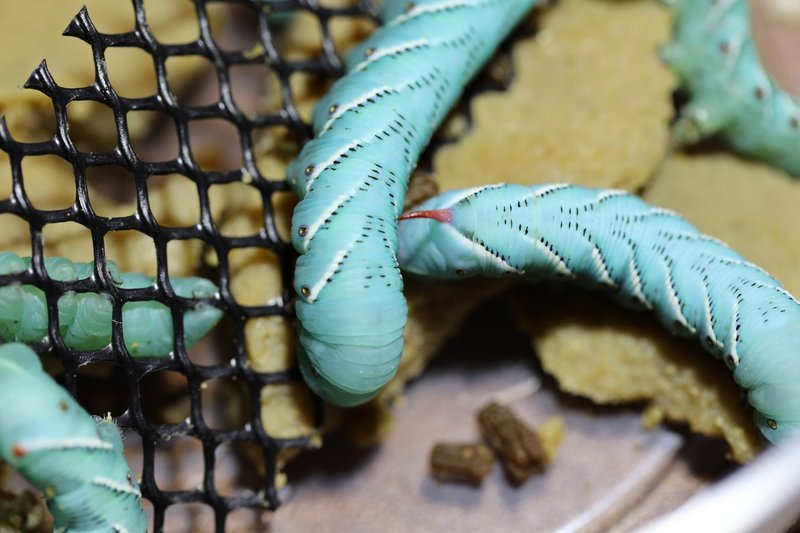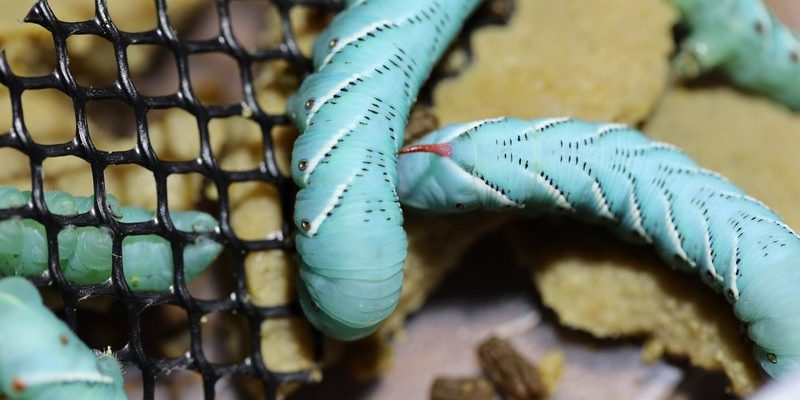
But before you jump in, let me explain what hornworms are and why they’re gaining popularity. Hornworms are the larvae of moths, specifically the Five-Spotted Hawkmoth or Tomato Hornworm. They’re great for feeding reptiles like bearded dragons, as well as amphibians, birds, and even some fish. Not only are they nutritious, but they also offer an exciting feeding experience, like a live buffet where your pets can hunt their food!
So how do you go about raising these critters? It’s not as daunting as it may seem. Let’s walk through everything you need to know about caring for and feeding hornworms.
Understanding Hornworms: The Basics
Hornworms are often recognized by their vibrant green color and the distinctive horn protruding from their rear end. They’re a favorite among many pet owners for a few reasons: they’re high in protein and relatively easy to raise. But before you get started, it’s essential to know their life cycle. Hornworms start as eggs laid by the adult moth, hatch into larvae (the hornworm), and eventually transform into moths. In your case, you’ll be focusing on the larvae stage since that’s the part you’ll be feeding to your pets.
These insects thrive in a suitable environment. They prefer warm, humid conditions, similar to a greenhouse. That means if you’re in a cooler area, you might need to provide some extra warmth. The good news is that they don’t require complex setups or fancy equipment. Just a basic container with proper ventilation will do. This is where your expertise in care and feeding comes into play!
Setting Up the Perfect Habitat
Creating a suitable habitat for your hornworms is vital. Here’s what you’ll need to consider:
- Container: A simple plastic container will work, but it should be vented to allow for airflow. A 10-gallon tank or a large plastic tub with holes is a good option. Make sure it’s escape-proof—hornworms are surprisingly clever!
- Substrate: You can line the bottom of the container with paper towels. This makes cleaning up their droppings easier and keeps them from getting too dirty.
- Temperature: Keep the environment between 70°F and 80°F. If it’s too cold, they won’t thrive; too hot, and they might not last long either.
Once you have your habitat set up, you can start populating it with your hornworms. You might be wondering whether to buy them or start with eggs. Purchasing baby hornworms can save you time, while starting with eggs requires patience as they hatch. Either way, ensure you have a plan for feeding them, as they’ll grow rapidly!
Feeding Hornworms: What to Provide
Feeding your hornworms properly is crucial for their health and growth. They consume a lot, so let’s break down their dietary needs:
Hornworms mainly feed on **nightshade plants**, primarily tomato and pepper leaves. If you have a garden, you might already have some of these plants. Here’s what you need to consider when feeding them:
- Fresh Leaves: Make sure the leaves are clean and free of pesticides. Feeding them healthy plants is key to their growth and your pet’s nutrition.
- Commercial Diets: There are also commercial hornworm diets available, specifically formulated for their growth. These can be a convenient option if you don’t have access to fresh leaves.
- Water: Hornworms get most of their moisture from their food, so keeping them hydrated shouldn’t be a problem. However, it’s a good idea to mist the habitat lightly if it seems too dry.
Remember, hornworms grow quickly and can double in size within a week! So, adjust their feeding based on their growth—too little food could stunt their growth.
Monitoring Hornworm Health
Keeping an eye on your hornworms is vital to ensure they’re healthy and thriving. Signs of a healthy hornworm include vibrant color, consistent growth, and active movement. If you notice any of the following, it might be time to investigate further:
- Pale Color: If they start looking a bit washed out, that’s a sign they’re not getting enough nutrition.
- Inactivity: If they’re sluggish or hiding, it could mean they’re either too cold or not feeling well.
- Excessive Shedding: Worms should shed their skin to grow. If they’re doing this more than usual, it could indicate an issue.
Taking immediate steps to correct any problems can prevent bigger issues down the line. You want your hornworms to be lively and healthy to ensure your pets get the best nutrition.
Harvesting Hornworms: When and How
Once your hornworms reach the right size (typically around 3-4 inches), it’s time to harvest them for feeding. This is where things get a bit tricky; you want to ensure that you’re doing it humanely and effectively. Here’s the scoop on harvesting:
1. **Choose Wisely:** Pick hornworms that are large but haven’t yet begun to pupate (look for a change in skin texture). If they start turning dark, they’re close to becoming moths, and their meat quality will decline.
2. **Use Gloves:** Handling hornworms can be a bit slimy, so it’s a good idea to wear gloves. This keeps them safe from oils on your skin and protects you.
3. **Clean Container:** If you’re storing them for a day or two before feeding, place them in a clean, ventilated container filled with fresh leaves.
4. **Feed Right Away:** Ideally, you want to serve them to your pets promptly after harvesting. Freshness is key for nutrition!
Remember, the more you handle them, the more stress they experience. So try to minimize handling once they’re harvested.
Common Challenges When Raising Hornworms
Even the most well-planned setups can run into hiccups. Here are some common challenges you might face and how to tackle them:
- Mold Growth: If your container is too humid, mold can quickly take over. Keeping proper ventilation and monitoring moisture levels will help prevent this.
- Escape Artists: Hornworms are known to wriggle their way out of containers. Make sure your habitat is tightly covered or has secure lids to avoid losing them.
- Overfeeding: While you want your hornworms to grow, too much food can spoil and lead to a messy habitat. Balance food supply with their consumption rate.
By staying vigilant and ready to troubleshoot, you’ll ensure smooth sailing in your hornworm raising venture.
Raising hornworms as feeder insects can be a rewarding experience, both for you and your pets. Not only do you get to provide fresh, nutritious food, but you also gain a deeper understanding of these fascinating creatures. With a little patience, care, and attention, you can create an ideal environment for your hornworms to thrive.
So, roll up your sleeves, set up your habitat, and get ready to dive into the world of hornworm raising. It’s a journey that brings you closer to nature and lets your pets enjoy the best snacks possible. Happy raising!

